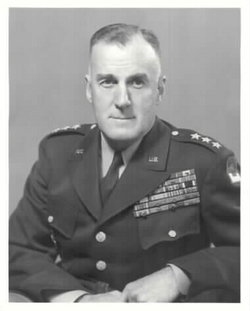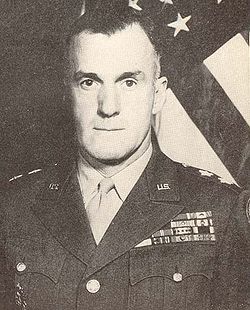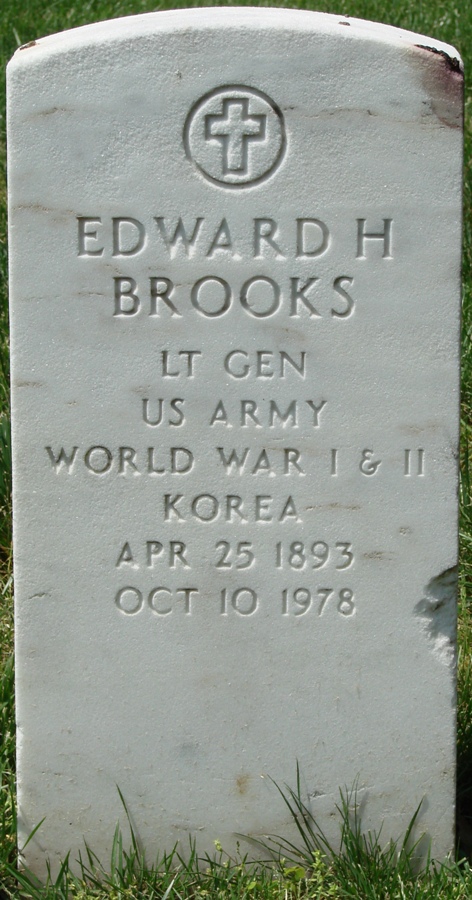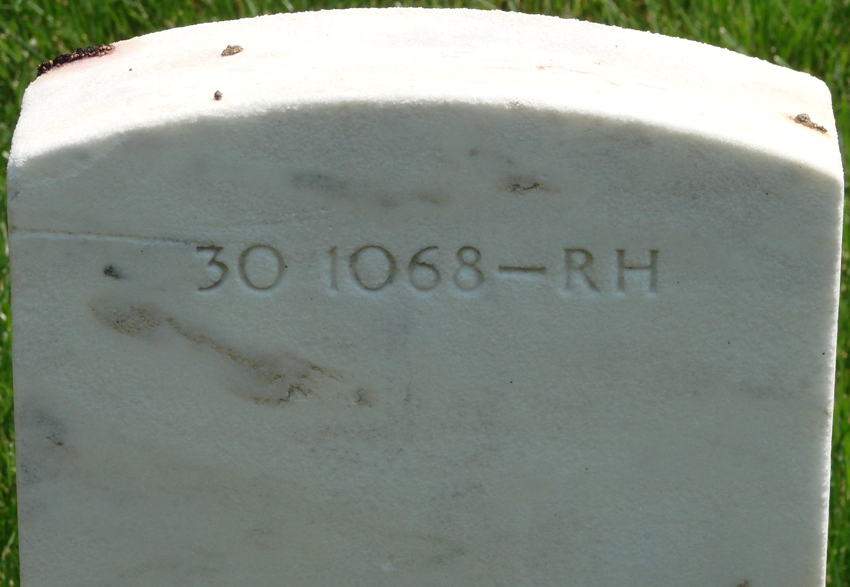Edward Hale (‘Ted') Brooks was born in Concord, NH, on 25 April 1893 to Edward Waite and Mary Frances (Hale) Brooks. His father was a grocer. Ted had three sisters, Harriet, Gertrude, and Alice; Gertrude and Alice both died in their infancy. He graduated from Concord High School, after which he attended Norwich University (The Military College of Vermont) in Northfield, VT, graduating in 1916 with a B.S. degree in Civil Engineering. Later, Ted also received a M.S. degree from Norwich University and an honorary doctoral degree in Military Science from Pennsylvania Military College.
Brooks' military career began in June 1915 as a Captain with the 1st Cavalry of the Vermont National Guard. During World War I, he served with the 3rd Infantry Division in five major engagements. He was first a battery commander in the 76th Field Artillery and later Assistant G-3 of the 3rd Field Artillery Brigade. During the Meuse-Argonne Offensive, he earned a Distinguished Service Cross when he "... exposed himself to heavy and accurate artillery fire directed on an ammunition train while driving a loaded ammunition truck to safety, the driver of which had been killed by enemy fire."
Capt. Brooks was in the Army of the Occupation in Europe until August 1919. On his return to the U.S., Ted played on the 3rd Division football team. In 1921, at the American Legion Convention in Kansas City, he captained the Army team that defeated Great Lakes Naval Training Station 20-6. Capt. Brooks served as a Gunnery instructor at Fort Sill, OK, from 1922 to 1926, then, in the Philippines, he commanded Battery D of the 24th Field Artillery Regiment, a pack mule outfit, for two years.
Ted was then transferred to Fort Riley, KS, serving there from 1928-1932. At Fort Riley his artillery battery, a horse drawn outfit, was the first to complete a 100-mile forced march in less than 24 hours. From 1932 to 1934 Brooks attended the Command and General Staff College at Fort Leavenworth, KS. He then served as ROTC instructor at Harvard University from 1934 to 1936. He attended the War College from 1936 to 1937 and was then served as an instructor in the attack section of the Command and General Staff College.
Having risen to the rank of Lieutenant Colonel, Brooks was chief of the statistics branch of the War Department General Staff from 1939 to 1941, where he was closely associated with General George C. Marshall and Secretary of War Henry L. Stimson. In September 1941, General Jacob L. Devers requested that Brooks be named to the staff of the new armored force being formed at Fort Knox, KY. With this position came promotion to Brigadier General. As a result, Ted never held the rank or wore the silver eagles of a Colonel (O-6). In 1942, Brooks was promoted again, to Major General. In this capacity he played a major role in the development of the M-7 self-propelled artillery piece and the Howitzer Motor Carriage M8, both potent forces in armored tactics.
From 1942 until 1944, MG Brooks established, and commanded, the 11th Armored Division at Fort Knox, KY, preparing them for the impending invasion of continental Europe. In March 1944, Brooks was sent to England to take command of the 2nd Armored Division ("Hell on Wheels") and led that elite unit into battle at Normandy on 9 June 1944. The division was prominent in the break-through at Saint-Lô, crossed the Rhine, and was said to be the first Allied division to enter Belgium. MG Brooks contributed, in particular, his skills in artillery coordination to the division. Brooks was awarded the Silver Star Medal for repeatedly attacking enemy positions along his line, and for the rapid commitment of his division against the enemy. He was cited for "personal gallantry and leadership," sometimes personally manning machine guns along with other senior officers.
General Brooks was known as "Standing Eddie" for his unusual habit of standing up in his jeep so he could better see his troops as he reviewed them. He even had a special railing welded to his jeep to hold onto. An example of his legendary fairness is the story of his hiking 20 miles in full pack in order to set a reasonable time in which to expect his troops to complete it.
Later in the war, Brooks commanded VI Corps and its nearly 150,000 men. Ted considered his accepting the surrender of the German's 19th and 24th Armies during this time (in Innsbruck, Austria on 5 May 1945, two days before V-E day) to be one of his greatest achievements.
On 22 September 1945, one of the greatest tragedies in Ted's life occurred when his son, Major Edward Hale Brooks, Jr. (USMA 1943), died in an airplane crash in Germany while piloting a bomber back to the United States after the war had ended. This left him with his wife, Bea, his daughter, Betty, and her husband, R. Potter Campbell, Jr. (USMA 1941).
On 18 March 1949, Ted was promoted to Lieutenant General when he was named Assistant Chief of Staff for Personnel (G-1). Brooks' final assignment, from 1951 until his retirement from active service in 1953, was as Commanding General of the Second Army at Fort Meade, MD.
At the time of Brooks' retirement, General Jacob L. Devers, the man responsible for getting Ted his first star, wrote the following: "Ted Brooks is a man of action. He accepts responsibility and then does something constructive about it—and he does it now, not tomorrow. He is a great fighter to have on your side, for he thinks only of the big objective and never of himself. He is quick and sound in his thinking—has tremendous courage—and will tackle any problem with new approaches until he gets the solution. His integrity is of the highest order, and he has great loyalty up and down. He knows when and where to disperse the work load, and when and where to concentrate it. His judgment is unquestionably sound. In addition, Ted has a wonderfully pleasing and dynamic personality. God has truly endowed him with wisdom and with an unfailing ability to understand his fellow man. A great soldier, a keen strategist, and a thoroughly capable administrator, Ted Brooks has all the qualities that would make him an excellent Chief of Staff of the Army."
From his country, Ted Brooks was awarded the following: Distinguished Service Cross, Silver Star Medal (2), Legion of Merit (2), Distinguished Service Medal - United States (2), Bronze Star Medal, Commendation Ribbon with Metal Pendant, World War I Victory Medal with 5 Battle Clasps, Army of Occupation of Germany Medal (World War I), American Defense Service Medal, American Campaign Medal, European-African-Middle Eastern Campaign Medal with 1 Silver Service Star, World War II Victory Medal, and National Defense Service Medal.
General Brooks also received the following foreign awards:
French: Legion of Honor, Rank of Officer. Croix de Guerre with Palm. Belgian: Commander of the Order of the Crown with Palm. Croix de Guerre with Palm. Netherlands: Order of Orange-Nassau with Swords, Rank of Grand Officer Chilean: Military Order of Chile, 1st Class
After retiring in 1953, Ted Brooks enjoyed 25 happy years in Concord, NH, dedicated to devoting time to his family, and his hobbies of fly-fishing and gardening. He also served on the board of directors of a local bank.
Ted was beloved and respected by his family. He taught his grandchildren and great-grandchildren to fish and camp, he cared about and was beloved by all the children of his family. No one could have asked for a finer man and role-model. Apparently his comrades felt likewise, for his walls were lined with signed pictures from the likes of Eisenhower, Churchill, Montgomery, Bradley and others, voicing their respect for the ‘great warrior.' He was the man called ‘the General', ‘the old Indian fighter', and ‘standing Eddie.' His grandchildren and great-grandchildren just called him Daddy-Pop, and all were better for having known him.
The following paragraph is an excerpt from Ted Brooks' eulogy as written and presented by General Charles D. Palmer:
"He was an exceptional and courageous leader who inspired confidence, demanded much of his subordinates but gave more of himself, was very strict but fair, never sought personal power and glory. He pushed forward deserving subordinates, but never pushed forward himself, was very modest and very human. Subordinates sometimes referred to him as a ‘lucky general' not meaning that he himself was lucky but that he was lucky for them - such was their confidence that he and they would succeed."
LTG Edward H. Brooks has Honoree Record 3264 at MilitaryHallofHonor.com.
Bio compiled by Charles A. Lewis
Edward Hale (‘Ted') Brooks was born in Concord, NH, on 25 April 1893 to Edward Waite and Mary Frances (Hale) Brooks. His father was a grocer. Ted had three sisters, Harriet, Gertrude, and Alice; Gertrude and Alice both died in their infancy. He graduated from Concord High School, after which he attended Norwich University (The Military College of Vermont) in Northfield, VT, graduating in 1916 with a B.S. degree in Civil Engineering. Later, Ted also received a M.S. degree from Norwich University and an honorary doctoral degree in Military Science from Pennsylvania Military College.
Brooks' military career began in June 1915 as a Captain with the 1st Cavalry of the Vermont National Guard. During World War I, he served with the 3rd Infantry Division in five major engagements. He was first a battery commander in the 76th Field Artillery and later Assistant G-3 of the 3rd Field Artillery Brigade. During the Meuse-Argonne Offensive, he earned a Distinguished Service Cross when he "... exposed himself to heavy and accurate artillery fire directed on an ammunition train while driving a loaded ammunition truck to safety, the driver of which had been killed by enemy fire."
Capt. Brooks was in the Army of the Occupation in Europe until August 1919. On his return to the U.S., Ted played on the 3rd Division football team. In 1921, at the American Legion Convention in Kansas City, he captained the Army team that defeated Great Lakes Naval Training Station 20-6. Capt. Brooks served as a Gunnery instructor at Fort Sill, OK, from 1922 to 1926, then, in the Philippines, he commanded Battery D of the 24th Field Artillery Regiment, a pack mule outfit, for two years.
Ted was then transferred to Fort Riley, KS, serving there from 1928-1932. At Fort Riley his artillery battery, a horse drawn outfit, was the first to complete a 100-mile forced march in less than 24 hours. From 1932 to 1934 Brooks attended the Command and General Staff College at Fort Leavenworth, KS. He then served as ROTC instructor at Harvard University from 1934 to 1936. He attended the War College from 1936 to 1937 and was then served as an instructor in the attack section of the Command and General Staff College.
Having risen to the rank of Lieutenant Colonel, Brooks was chief of the statistics branch of the War Department General Staff from 1939 to 1941, where he was closely associated with General George C. Marshall and Secretary of War Henry L. Stimson. In September 1941, General Jacob L. Devers requested that Brooks be named to the staff of the new armored force being formed at Fort Knox, KY. With this position came promotion to Brigadier General. As a result, Ted never held the rank or wore the silver eagles of a Colonel (O-6). In 1942, Brooks was promoted again, to Major General. In this capacity he played a major role in the development of the M-7 self-propelled artillery piece and the Howitzer Motor Carriage M8, both potent forces in armored tactics.
From 1942 until 1944, MG Brooks established, and commanded, the 11th Armored Division at Fort Knox, KY, preparing them for the impending invasion of continental Europe. In March 1944, Brooks was sent to England to take command of the 2nd Armored Division ("Hell on Wheels") and led that elite unit into battle at Normandy on 9 June 1944. The division was prominent in the break-through at Saint-Lô, crossed the Rhine, and was said to be the first Allied division to enter Belgium. MG Brooks contributed, in particular, his skills in artillery coordination to the division. Brooks was awarded the Silver Star Medal for repeatedly attacking enemy positions along his line, and for the rapid commitment of his division against the enemy. He was cited for "personal gallantry and leadership," sometimes personally manning machine guns along with other senior officers.
General Brooks was known as "Standing Eddie" for his unusual habit of standing up in his jeep so he could better see his troops as he reviewed them. He even had a special railing welded to his jeep to hold onto. An example of his legendary fairness is the story of his hiking 20 miles in full pack in order to set a reasonable time in which to expect his troops to complete it.
Later in the war, Brooks commanded VI Corps and its nearly 150,000 men. Ted considered his accepting the surrender of the German's 19th and 24th Armies during this time (in Innsbruck, Austria on 5 May 1945, two days before V-E day) to be one of his greatest achievements.
On 22 September 1945, one of the greatest tragedies in Ted's life occurred when his son, Major Edward Hale Brooks, Jr. (USMA 1943), died in an airplane crash in Germany while piloting a bomber back to the United States after the war had ended. This left him with his wife, Bea, his daughter, Betty, and her husband, R. Potter Campbell, Jr. (USMA 1941).
On 18 March 1949, Ted was promoted to Lieutenant General when he was named Assistant Chief of Staff for Personnel (G-1). Brooks' final assignment, from 1951 until his retirement from active service in 1953, was as Commanding General of the Second Army at Fort Meade, MD.
At the time of Brooks' retirement, General Jacob L. Devers, the man responsible for getting Ted his first star, wrote the following: "Ted Brooks is a man of action. He accepts responsibility and then does something constructive about it—and he does it now, not tomorrow. He is a great fighter to have on your side, for he thinks only of the big objective and never of himself. He is quick and sound in his thinking—has tremendous courage—and will tackle any problem with new approaches until he gets the solution. His integrity is of the highest order, and he has great loyalty up and down. He knows when and where to disperse the work load, and when and where to concentrate it. His judgment is unquestionably sound. In addition, Ted has a wonderfully pleasing and dynamic personality. God has truly endowed him with wisdom and with an unfailing ability to understand his fellow man. A great soldier, a keen strategist, and a thoroughly capable administrator, Ted Brooks has all the qualities that would make him an excellent Chief of Staff of the Army."
From his country, Ted Brooks was awarded the following: Distinguished Service Cross, Silver Star Medal (2), Legion of Merit (2), Distinguished Service Medal - United States (2), Bronze Star Medal, Commendation Ribbon with Metal Pendant, World War I Victory Medal with 5 Battle Clasps, Army of Occupation of Germany Medal (World War I), American Defense Service Medal, American Campaign Medal, European-African-Middle Eastern Campaign Medal with 1 Silver Service Star, World War II Victory Medal, and National Defense Service Medal.
General Brooks also received the following foreign awards:
French: Legion of Honor, Rank of Officer. Croix de Guerre with Palm. Belgian: Commander of the Order of the Crown with Palm. Croix de Guerre with Palm. Netherlands: Order of Orange-Nassau with Swords, Rank of Grand Officer Chilean: Military Order of Chile, 1st Class
After retiring in 1953, Ted Brooks enjoyed 25 happy years in Concord, NH, dedicated to devoting time to his family, and his hobbies of fly-fishing and gardening. He also served on the board of directors of a local bank.
Ted was beloved and respected by his family. He taught his grandchildren and great-grandchildren to fish and camp, he cared about and was beloved by all the children of his family. No one could have asked for a finer man and role-model. Apparently his comrades felt likewise, for his walls were lined with signed pictures from the likes of Eisenhower, Churchill, Montgomery, Bradley and others, voicing their respect for the ‘great warrior.' He was the man called ‘the General', ‘the old Indian fighter', and ‘standing Eddie.' His grandchildren and great-grandchildren just called him Daddy-Pop, and all were better for having known him.
The following paragraph is an excerpt from Ted Brooks' eulogy as written and presented by General Charles D. Palmer:
"He was an exceptional and courageous leader who inspired confidence, demanded much of his subordinates but gave more of himself, was very strict but fair, never sought personal power and glory. He pushed forward deserving subordinates, but never pushed forward himself, was very modest and very human. Subordinates sometimes referred to him as a ‘lucky general' not meaning that he himself was lucky but that he was lucky for them - such was their confidence that he and they would succeed."
LTG Edward H. Brooks has Honoree Record 3264 at MilitaryHallofHonor.com.
Bio compiled by Charles A. Lewis













